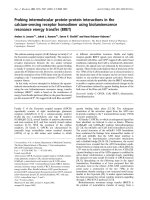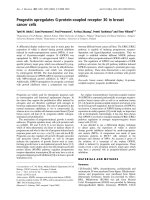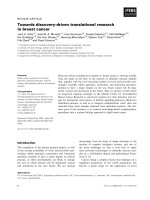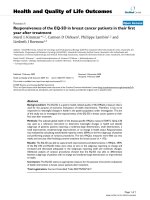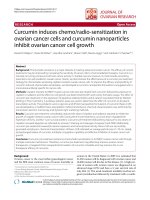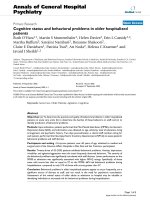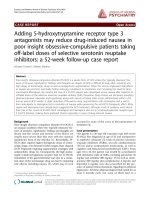Báo cáo Y học: Progestin upregulates G-protein-coupled receptor 30 in breast cancer cells pot
Bạn đang xem bản rút gọn của tài liệu. Xem và tải ngay bản đầy đủ của tài liệu tại đây (204.04 KB, 6 trang )
Progestin upregulates G-protein-coupled receptor 30 in breast
cancer cells
Tytti M. Ahola
1
, Sami Purmonen
1
, Pasi Pennanen
1
, Ya-Hua Zhuang
1
, Pentti Tuohimaa
3
and Timo Ylikomi
1,2
1
Department of Cell Biology, Medical School, 33014 University of Tampere, Finland;
2
Department of Clinical Chemistry, Tampere
University Hospital, Finland;
3
Department of Anatomy, University of Tampere, Finland
A differential display method was used to study genes the
expression of which is altered during growth inhibition
induced by medroxyprogesterone acetate (MPA). A tran-
script of G-protein-coupled receptor 30 (GPR30) was
upregulated by MPA in estrogen-treated MCF-7 breast
cancer cells. Northern-blot analysis showed a progestin-
specific primary target gene, which was enhanced by prog-
esterone and different progestins, but not by dihydrotestos-
terone or dexamethasone, and which was abrogated
by antiprogestin RU486. The dose-dependent and time-
dependent increase in GPR30 mRNA expression correlated
with MPA-induced growth inhibition in MCF-7 cells.
Additionally, GPR30 upregulation by progestin correlated
with growth inhibition when a comparison was made
between different breast cancer cell lines. The ERK1/ERK2
pathway is capable of inducing progesterone receptor-
dependent and ligand-dependent transcription. Thus we
sought to establish whether different MAPK pathway
inhibitors affect progestin-induced GPR30 mRNA regula-
tion. The regulation of GPR30 was independent of ERK
pathway activation, but the p38 pathway inhibitor induced
GPR30 expression, which suggested a potential gene regu-
lation pathway. These data demonstrate a new progestin
target gene, the expression of which correlates with growth
inhibition.
Keywords: breast cancer; differential display; G-protein-
coupled receptor; progestin; proliferation.
Progestins are widely used for therapeutic purposes such
as contraception and hormonal replacement therapy. In
the uterus they oppose the proliferative effect induced by
estrogens and are therefore combined with estrogen in
hormone replacement therapy. The role of progestins in the
normal mammary epithelium in vivo is controversial [1],
whereas in in vitro studies with human normal breast [2] and
breast cancer cell lines [3–5], progestins inhibit estrogen-
stimulated cell proliferation.
The mechanism of progestin-induced growth is mostly
unknown. Progestin regulates many cell cycle proteins such
as cyclinD1, D3 and A [6,7]. It is not known, however,
which of these phenomena are direct or indirect effects of
progesterone and what is the role of progestin-induced early
response genes such as c-myc,c-fos [5], c-jun and jun-B[8].
Progestins can also regulate cell growth through autocrine
and paracrine factors. Progestins as well as estrogen
enhance the expression of growth factors such as trans-
forming growth factor a and epidermal growth factor [1,5].
Interestingly, recent studies show that the mitogen-activated
protein kinase (MAPK) pathway regulates progesterone
receptor-dependent transcription [9] and may have a role in
progestin-induced growth inhibition [10] as it does in growth
stimulation [11].
An orphan transmembrane G-protein-coupled receptor
30 (GPR30) is expressed preferentially in estrogen receptor-
positive breast cancer cells as well as in endocrine tissues
[12–14]. Some G-protein-coupled receptors are known to be
involved in growth regulation, but the function of GPR30 is
not known. Conservation of GPR30 during evolution and
expression in embryogenesis [13] would imply an important
role in development. Interestingly, it has also been shown
that GPR30 is involved in estrogen-mediated ERK1/ERK2
pathway regulation in estrogen receptor-negative breast
cancer cells [15,16].
It was decided to use a differential display technique
to detect genes, the expression of which is altered
during growth inhibition induced by medroxyprogester-
one acetate (MPA). A comparison was made of gene
expression patterns in MCF-7 cells cultured in the
presence and absence of MPA. An account is given of
the isolation of a transcript of the orphan GPR30,
which is induced by progestins and progesterone. These
results reveal a new progestin primary target gene which
may have a potential role in progestin-induced growth
inhibition.
MATERIALS AND METHODS
Hormones
17b-Estradiol, MPA, dexamethasone, cycloheximide and
actinomycin D were purchased from Sigma. Dihydrotesto-
sterone and progesterone were purchased from Merck
(Darmstadt, Germany). Insulin was provided by Gibco/
BRL. Mifepristone (RU486) was gift from Roussel
Uclaf. Promegesterone (R5020) was provided by Schering
Aktiengesellschaft (Berlin, Germany). PD98059, U0126
Correspondence to T. M. Ahola, Medical School, Department of Cell
Biology, 33014 University of Tampere, Finland.
Fax: + 358 3 215 6170, Tel.: + 358 3 215 8942,
E-mail: ta55935@uta.fi
Abbreviations: MAPK, mitogen-activated protein kinase; GPR30,
G-protein-coupled receptor 30; MPA, medroxyprogesterone acetate;
TBP, TATA binding protein.
(Received 11 February 2002, accepted 3 April 2002)
Eur. J. Biochem. 269, 2485–2490 (2002) Ó FEBS 2002 doi:10.1046/j.1432-1033.2002.02912.x
and SB202190, SAPK2/p38 MAPK inhibitor were from
Calbiochem.
Cell culture
MCF-7 and ZR-75-1 cells were provided by Professor P.
Ha
¨
rko
¨
nen, University of Turku. CAMA-1 and BT-474 cells
were a gift from Professor J. Isola, University of Tampere.
Before the experiment, MCF-7, ZR-75-1, CAMA-1 and
BT-474 cells were cultured for two to three passages in
phenol red free in Dulbecco’s modified Eagle’s medium/
Ham’s nutrient mixture F12 (1 : 1) supplemented with 5%
dextran-coated, charcoal-stripped fetal bovine serum,
100 UÆmL
)1
penicillin, 100 lgÆmL
)1
streptomycin and
insulin (phenol red free and DCC medium; dextran-coated,
charcol-stripped) with 1 n
M
estrogen.
Cell growth assay
Cells were seeded in 96-well plates at a density of 3 · 10
3
cells per well in the phenol red free and DCC medium. They
were allowed to attach overnight and the medium was
replaced. After 24 h, appropriate steroid hormones in 100%
ethanol or ethanol were added. The final ethanol concen-
tration did not exceed 0.1%. The number of cells was
measured using the crystal violet method [17]. Absorbance
was measured at a wavelength of 590 nm using a Victor
1420 Multilabel counter (Wallac).
Differential display
MCF-7 cells (1.0 million) were placed in 150-cm
2
plates and
treated as in the cell growth assay. RNA was extracted using
TRIzol Reagent (Gibco/BRL) according to the manufac-
turer’s protocol, and then digested with DNase I (Promega)
for 1 h at 37 °C. The digested RNA was extracted with
phenol/chloroform and precipitated with ethanol.
The differential display was carried out using the
RNAmap KIT (GenHunter, Brookline, MA, USA)
according to the manufacturer’s instructions. DNase-
treated RNA (1 lg) was reverse-transcribed and subse-
quently amplified using an upstream primer (AP1, AP2,
AP3, AP4 or AP5), a downstream primer T
12
MN
(N ¼ T, A, C or G) and [
33
P]dATP (1000 CiÆmmol
)1
)
(Amersham). PCR products (5 lL) were run on 6%
polyacrylamide sequencing gels for 6 h at 1000 V using
Poker Face II (Hoefer Scientific Instruments, San
Francisco, CA, USA). After autoradiography, differen-
tially expressed products were extracted from the gel with
boiling water and reamplified. The reamplified PCR
product was subcloned in a PCR-TRAP vector (Pharma-
cia Biotech). The insert was sequenced using the Dye
Terminator cycle sequencing Ready Reaction kit (ABI
Prism), and the samples were then processed on an
automated 310 Genetic Analyser (ABI Prism).
Northern blot
Total RNA (30–40 lg) was electrophoresed on a denaturing
1% agarose/2% formaldehyde gel. The RNA was blotted
on to a nitrocellulose membrane (MSI, Westborough, MA,
USA) using overnight capillary transfer in 10 · NaCl/P
i
/
EDTA. The membrane was hybridized with a randomly
primed
32
P-labeled cloned PCR product for 16 h at 42 °Cin
the hybridization solution (6 · NaCl/P
i
/EDTA/5 · Den-
hardt’s solution/50% deionized formamide/0.1% SDS/
100 lgÆmL
)1
denatured salmon sperm DNA). The filters
were rehybridized with oligonucleotide complementary to
18S rRNA (Ambion) for normalization. The radiolabeled
filters were exposed on X-ray film (Kodak BioMax). Signal
density was measured using a Wallac densitometer.
Proliferation assay
Cells were placed on top of glass slides in four-well plates at
adensityof10
5
cells per well. Bromodeoxyuridine (BrdU)
was added at a final concentration of 20 l
M
at the
indicated time points. After 2 h, the cells were washed three
times with NaCl/P
i
,fixedwith4%paraformaldehydefor
15 min at room temperature, and washed with NaCl/P
i
.
The fixed cells were permeabilized, and the DNA was
denatured as previously described [18]. Thereafter, the cells
were immunohistochemically stained using the ABC
method [19] with the following modifications. After
20 min blocking with 10% normal horse serum, monoclo-
nal anti-BrdU (Sigma) 36 lgÆmL
)1
or anti-Ki-67 (Boehrin-
ger-Mannheim), 0.2 lgÆmL
)1
was added in NaCl/P
i
containing 1% normal horse serum and 100 UÆmL
)1
nuclease S1 (Promega) for 1 h.
LightCycler RT-PCR analysis
One-step RT-PCR was performed with a LightCycler
instrument (Roche) in a total volume of 20 lL containing
100 ng total RNA, 3.25 m
M
manganese acetate and 0.5 l
M
each primer. LightCycler RNA Master SYBR Green I kit
(Roche) was used. The reverse transcription was performed
at 61 °C for 20 min, and the denaturation at 95 °Cfor
2 min. Forty cycles of PCR were carried out. Each cycle of
PCR included denaturation at 95 °C, 5 s of primer anneal-
ing at 58 °C and 10 s of extension at 72 °C. After amplifi-
cation, a melting curve was obtained by heating at 20 °C/s to
95 °C, cooling at 20 °C/s to 65 °C and slowly heating at
0.1 °C/s to 95 °C with fluorescence data collection at 0.1 °C
intervals. The following primers (Amersham Pharmacia
Biotech) were used for PCR: GPR30-forward, 5¢-AGTCGG
ATGTGAGGTTCAG-3¢; GPR30-reverse, 5¢-TCTGTGT
GAGGAGTGCAAG-3¢; TBP-forward, 5¢-TTTGGAAG
AGCAACAAAGG-3¢; TBP-reverse, 5¢-AAGGGTGCAG
TTGTGAGAG-3¢.
TBP was used to normalize the RNA samples. These
primer pairs result in PCR products of 240 bp (GPR30) and
243 bp (TBP). LightCycler data were quantitatively ana-
lysed using LightCycler analysis software. The final results,
expressed as N-fold differences in GPR30 gene expression
between untreated and MPA-treated samples, were deter-
mined as follows:
N
GPR30
¼ (GPR30
treated
=TBP
treated
Þ=
(GPR30
untreated
=TBP
untreated
Þ
The relative concentrations used for expression difference
calculations were obtained from the calibration curves.
Concentration values for TBP were taken from the calib-
ration curve made with TBP, and, in the same way,
concentration values for GPR30 were taken from the
2486 T. M. Ahola et al.(Eur. J. Biochem. 269) Ó FEBS 2002
calibration curve made with GPR30. In both cases the serial
dilutions were 500 : 100 : 20 : 5 ng of the total RNA.
Statistical analysis
Data for the correlation analysis were handled using a
regression analysis of
SSPI
and/or a correlation analysis of
EXCEL
. Data for the growth studies and immunochemistry
were analysed by a paired two-tailed t-test. Differences of
P < 0.05 were considered significant (*), and P <0.01
(**) and P < 0.001 (***) highly significant.
RESULTS
Cloning of genes, the expression of which is altered
during progestin-induced growth inhibition
To study genes associated with progestin-induced growth
inhibition, a comparison was made of the gene expression
patterns in MCF-7 breast cancer cells cultured inthe presence
of MPA and estrogen with estrogen-treated control cells by
the differential display PCR technique. Using 20 different
primer combinations, cDNA fragments were detected. These
were regulated by MPA 24or 48 h after administration ofthe
MPA. The amplification products were isolated and ream-
plified. The cDNA fragments were subsequently cloned and
sequenced. In a
BLAST
search, two of the transcripts showed
96–100% identity with the GPR30, and there was no
significant similarity to any other genes. These were
expressed in MPA-treated cells, but not in the control cells
at either 24 or 48 h in differential display analysis.
Progestins upregulate GPR30 mRNA in MCF-7 breast
cancer cells
Northern-blot analysis was used to confirm the MPA-
dependent regulation and to study the steroid specificity of
GPR30 expression in MCF-7 breast cancer cells. Northern-
blot analysis revealed a single GPR30 mRNA species of
approximate size 3 kb. As shown in Fig. 1A, MPA, R5020
and progesterone had increased GPR30 expression three-
fold to fourfold 48 h after administration, whereas dexa-
methasone and dihydrotestosterone failed to induce a
significant increase in GPR30 expression. A 10-fold excess
of antiprogestin RU486 abrogated MPA-induced GPR30
expression (Figs 1B and 2A, lanes 1, 5, 7 and 8), which
further indicated progestin specificity of GPR30 expression.
When administered alone, RU486 did not induce GPR30
mRNA expression.
Treatment with cycloheximide (a protein synthesis inhib-
itor) did not prevent progestin-induced upregulation of
GPR30 and had no effect on GPR30 mRNA levels at 24 h
in MCF-7 cells (Fig. 1C). An RNA synthesis inhibitor did
not regulate GPR30 mRNA, but abrogated the induction of
GPR30 mRNA.
GPR30 expression correlated with progestin-induced
growth inhibition in breast cancer cells
Figure 2A shows that GPR30 mRNA expression correlated
with cell growth as the dose of MPA increased; this further
indicated progestin-dependent GPR30 regulation. GPR30
mRNA expression was increased approximately threefold
by 0–0.1 n
M
MPA, and cell growth was decreased according
to the dose of MPA. There was a significant correlation
(P <0.01,r ¼ )0.91) between growth and the level of
expression of GPR30.
MCF-7 cells were grown in the presence of 10 n
M
MPA
to determine the time sensitivity of the hormone action, in
particular, to determine whether there was a correlation
between the onset of the reduced rate of cell proliferation
and GPR30 mRNA upregulation. RNA was extracted at 2,
8, 18 and 24 h for the Northern-blot analysis. GPR30
mRNA started to increase between 8 and 18 h after MPA
Fig. 1. GPR30 mRNA is a direct target gene of progestin. GPR30 mRNA expression was analysed from the total RNA of MCF-7 cells treated with
the indicated factors using Northern blotting and
32
P-labeled GPR30 cDNA fragment as a probe. The intensity of the bands was quantified by
densitometry and normalized using ribosomal 18S mRNA bands. (A) MCF-7 cells were incubated with 10 n
M
MPA, R5020, progesterone,
dihydrotestosterone or dexamethasone for 48 h. (B) Cells were incubated with 10 n
M
MPA with and without 100 n
M
RU486 for 48 h to study the
effect of antiprogestin on MPA-induced GPR30 expression. (C) MPA-treated and untreated cells were incubated for 24 h with 20 lgÆmL
)1
cycloheximide and 5 lgÆmL
)1
actinomycin D to investigate the effects of protein synthesis inhibitor and RNA synthesis inhibitor on GPR30
expression. Results are the means of two separate experiments.
Ó FEBS 2002 GPR30 and progestin (Eur. J. Biochem. 269) 2487
administration and had been induced threefold at 24 h, as
revealed by Northern blotting (Fig. 2B). Cell proliferation,
measured using BrdU and immunohistochemistry, was
decreased to below control levels 12–24 h after MPA
administration. BrdU incorporation was decreased 32%,
54% and 44% by MPA at 24, 48 and 72 h, respectively.
There was correlation between the onset of growth inhibi-
tion and MPA-induced GPR30 mRNA upregulation
(r ¼ )0.94).
We cultured different breast cancer cell lines with MPA to
study how GPR30 is regulated by progestin, and how the
expression of GPR30 is related to growth in these cells.
Relative cell growth was measured at 120 h and GPR30
mRNA upregulation was detected at 48 h using Light-
Cycler analysis in CAMA-1, MCF-7, ZR-75-1 and BT-474
cells. Different cell lines showed different responses to the
progestin treatment. The magnitude of GPR30 expression
correlated (r ¼ )0.91) with progestin-induced growth
inhibition when a comparison was made between the cell
lines (Fig. 2C).
Progestin-induced GPR30 regulation is not mediated
through the ERK pathway
To investigate whether the ERK1/ERK2 pathway mediates
progestin-induced GPR30 mRNA regulation, MCF-7 cells
were treated with the ERK pathway inhibitors PD98059,
U0126 and SAPK2/p38 MAPK inhibitor SB202190, with
and without MPA. MEK inhibitors neither markedly
regulated GPR30 mRNA nor altered MPA-stimulated
GPR30 expression analysed by quantitative PCR Light-
Cycler (Fig. 3). However, p38 inhibitor enhanced GPR30
mRNA expression threefold, fourfold and 40-fold in the
three separate experiments. On average, MPA did not have
any additional affect on SB202190-induced GPR30 mRNA
upregulation.
DISCUSSION
A differential display technique was used to isolate cDNA
fragments from MPA-treated MCF-7 breast cancer cells.
On the basis of preliminary verification of discovered clones,
we were able to detect gene regulation by MPA in the case
of six genes. Most of the PCR fragments showed homology
with mitochondrial enzymes; one was unknown and two of
them showed similarity to potentially growth-associated
genes. An orphan transmembrane GPR30 was selected for
Fig. 2. GPR30 mRNA upregulation correlates with progestin-induced
growth inhibition. MCF-7 cells were treated with MPA to study whe-
ther GPR30 mRNA upregulation and growth are related. Relative cell
numbers were measured at 120 h and RNA extracted for Northern-
blot analysis at 48 h unless otherwise indicated. Cells grown without
MPA were used as a control. (A) The increase in GPR30 mRNA
expression and progestin-induced growth inhibition were dose-
dependent. The values in the growth curve (j)arethemeanvaluesof
four replicates, and in the Northern analysis (h)themeanvaluesof
two replicates. (B) The time sensitivity of GPR30 mRNA expression
correlated with the beginning of progestin-induced growth inhibition.
MCF-7 cells were treated with MPA for 2–24 h and RNA was extrac-
ted for Northern blotting to analyse the mRNA. Cell proliferation was
measured using BrdU and immunostaining. (C) GPR30 upregulation
(h) in different breast cancer cell lines correlated with growth (j).
RNA was analysed by quantitative PCR using a LightCycler.
2488 T. M. Ahola et al.(Eur. J. Biochem. 269) Ó FEBS 2002
further studies because it has been shown to be expressed
preferentially in endocrine tissues [12–14], and some
G protein-coupled receptors are known to be involved in
growth regulation.
The regulation of GPR30 expression in MCF-7 cells was
progestin specific and was not upregulated by other steroid
hormones. Very few progestin-specific genes are reported in
breast cancer cells [20,21]. The expression of GPR30 was
enhanced late (between 8 and 18 h) after progestin admin-
istration, which suggested that it is not the primary target
gene for progestins. Surprisingly, however, the protein
synthesis inhibitor cycloheximide did not abolish the
induction, which suggested that GPR30 is directly regulated
by progestins. We were not able to locate any progestin
response elements in the promoter and regulatory region of
GPR30 gene. Only the AP-1-binding site has been mapped
in the promoter. It is possible that this could mediate the
effect of progestin on gene transcription [12,22,23].
It has been previously established that the ERK pathway
activates progestin-dependent transcription in the presence
of ligand [9]. Because GPR30 mRNA was expressed in
MCF-7 cells relatively late, although in a progestin-
dependent manner, we decided to investigate whether
MAPK activation is responsible for GPR30 mRNA
regulation by progestin. Progestin-induced GPR30 mRNA
regulation was not altered by MEK inhibitors, which
suggested that GPR30 regulation is not dependent on the
ERK pathway. Unexpectedly however, p38 inhibitor
induced GPR30 expression. Progestin did not have any
significant additional effect on p38 inhibitor-regulated
GPR30 mRNA expression. The fact that progestin [3–5]
and p38 pathway inactivation [24,25] have the same kind of
effect on proliferation of MCF-7 cells may suggest a
common target of the growth factors and steroid hormones.
Progestin administration causes an initial increase in cell
proliferation lasting about 12–24 h and subsequent
inhibition of proliferation [6,26]. The late expression of
GPR30 after progestin administration was thus associated
with the beginning of growth inhibition by progestins.
GPR30 mRNA is regulated according to the dose of
progestin, which also correlated with progestin-induced
growth inhibition. More importantly, when a comparison
was made between different breast cancer cell lines, there
was a correlation between GPR30 upregulation and prog-
estin-induced growth inhibition.
The ligand of GPR30 and its role in growth regulation are
not known. In amino acid sequence comparisons, GPR30
shows similarity to a number of proteins; the highest identity
is with angiotensin II type 1, interleukin 8 and C-C chem-
okine receptors. Chemokines [27,28] and angiotensin II [29]
have both shown growth-inhibiting properties with different
cancers. Interestingly, an orphan receptor (GPR41 in the
rat), which shows a high degree of similarity to GPR30,
induces apoptosis during ischemic hypoxia [30].
The results show a progestin target gene, an orphan
receptor GPR30, the expression of which correlated with
growth inhibition. The potential importance of the
G-proteins in progestin-mediated signaling is also highligh-
ted by a study showing that half of the progesterone-
regulated genes were involved in membrane-initiated events
[31]. It is still not known, however, which pathway mediates
the progestin effect on the cell cycle regulatory molecules
during growth inhibition. Thus our results establish a
candidate gene that may be involved in progestin-induced
growth inhibition.
ACKNOWLEDGEMENTS
We thank A. Vienonen for advice. This work was supported by the
Medical Research Foundation of Tampere University Hospital,
Biomed 2 project PL 963433 and the Cancer Foundation in Pirkanmaa.
REFERENCES
1. Clarke, C.L. & Sutherland, R.L. (1990) Progestin regulation of
cellular proliferation. Endocr. Rev. 11, 266–301.
2. Gompel, A., Malet, C., Spritzer, P., Lalardrie, J.P., Kuttenn, F. &
Mauvais-Jarvis, P. (1986) Progestin effect on cell proliferation and
17 beta-hydroxysteroid dehydrogenase activity in normal human
breast cells in culture. J. Clin. Endocrinol. Metab. 63, 1174–1180.
3. Schoonen, W.G., Joosten, J.W. &Kloosterboer, H.J. (1995) Effects
of two classes of progestagens, pregnane and 19-nortestosterone
derivatives, on cell growth of human breast tumor cells. I. MCF-7
cell lines. J. Steroid Biochem. Mol. Biol. 55, 423–437.
4. Sutherland, R.L., Hall, R.E., Pang, G.Y., Musgrove, E.A. &
Clarke, C.L. (1988) Effect of medroxyprogesterone acetate on
proliferation and cell cycle kinetics of human mammary carci-
noma cells. Cancer Res. 48, 5084–5091.
5. Musgrove, E.A., Lee, C.S. & Sutherland, R.L. (1991) Progestins
both stimulate and inhibit breast cancer cell cycle progression
while increasing expression of transforming growth factor alpha,
epidermal growth factor receptor, c-fos,andc-myc genes. Mol.
Cell. Biol. 11, 5032–5043.
6. Groshong, S.D., Owen, G.I., Grimison, B., Schauer, I.E., Todd,
M.C., Langan, T.A., Sclafani, R.A., Lange, C.A. & Horwitz, K.B.
(1997) Biphasic regulation of breast cancer cell growth by
progesterone: role of the cyclin-dependent kinase inhibitors, p21
and p27 (Kip1). Mol. Endocrinol. 11, 1593–1607.
7. Musgrove, E.A., Swarbrick, A., Lee, C.S., Cornish, A.L. &
Sutherland, R.L. (1998) Mechanisms of cyclin-dependent kinase
inactivation by progestins. Mol. Cell. Biol. 18, 1812–1825.
Fig. 3. GPR30 mRNA is upregulated by p38 inhibitor, but not altered
by the ERK1/ERK2 pathway. To study whether the MAPK pathway
regulates progestin-induced gene transcription, MCF-7 cells were
treated with MPA with and without the MEK inhibitors: 50 l
M
PD98059 (P), 100 n
M
U0126 (U) and 100 n
M
SAPK2/p38 MAPK
inhibitor SB202190 (S). RNA was extracted at 48 h and used for
quantitative PCR LightCycler analysis. The results are expressed as a
percentage of that in estrogen-treated control cells (100%).
Ó FEBS 2002 GPR30 and progestin (Eur. J. Biochem. 269) 2489
8. Alkhalaf, M. & Murphy, L.C. (1992) Regulation of c-jun and
jun-B by progestins in T-47D human breast cancer cells. Mol.
Endocrinol. 6, 1625–1633.
9. Shen, T., Horwitz, K.B. & Lange, C.A. (2001) Transcriptional
hyperactivity of human progesterone receptors is coupled to their
ligand-dependent down-regulation by mitogen-activated protein
kinase-dependent phosphorylation of serine 294. Mol. Cell Biol.
21, 6122–6131.
10. Boonyaratanakornkit, V., Scott, M.P., Ribon, V., Sherman, L.,
Anderson, S.M., Maller, J.L., Miller, W.T. & Edwards, D.P.
(2001) Progesterone receptor contains a proline-rich motif that
directly interacts with SH3 domains and activates c-Src family
tyrosine kinases. Mol. Cell 8, 269–280.
11. Castoria, G., Barone, M.V., Di Domenico, M., Bilancio, A.,
Ametrano, D., Migliaccio, A. & Auricchio, F. (1999) Non-
transcriptional action of oestradiol and progestin triggers DNA
synthesis. EMBO J. 18, 2500–2510.
12. Carmeci, C., Thompson, D.A., Ring, H.Z., Francke, U. & Wei-
gel, R.J. (1997) Identification of a gene (GPR30) with homology
to the G-protein-coupled receptor superfamily associated with
estrogen receptor expression in breast cancer. Genomics 45,
607–617.
13. Feng, Y. & Gregor, P. (1997) Cloning of a novel member of the
G protein-coupled receptor family related to peptide receptors.
Biochem. Biophys. Res. Commun. 231, 651–654.
14. Owman, C., Blay, P., Nilsson, C. & Lolait, S.J. (1996) Cloning of
human cDNA encoding a novel heptahelix receptor expressed in
Burkitt’s lymphoma and widely distributed in brain and peripheral
tissues. Biochem. Biophys. Res. Commun. 228, 285–292.
15. Filardo, E.J., Quinn, J.A., Bland, K.I. & Frackelton, A.R. Jr
(2000) Estrogen-induced activation of Erk-1 and Erk-2 requires
the G protein- coupled receptor homolog, GPR30, and occurs via
trans-activation of the epidermal growth factor receptor through
release of HB-EGF. Mol. Endocrinol. 14, 1649–1660.
16. Filardo, E.J., Quinn, J.A., Frackelton, A.R. Jr & Bland, K.I.
(2002) Estrogen action via the G protein-coupled receptor,
GPR30. Stimulation of adenylyl cyclase and cAMP-mediated
attenuation of the epidermal growth factor receptor-to-MAPK
signaling axis. Mol. Endocrinol. 16, 70–84.
17. Kueng, W., Silber, E. & Eppenberger, U. (1989) Quantification of
cells cultured on 96-well plates. Anal. Biochem. 182, 16–19.
18. Simonson, M.S., LePage, D.F. & Walsh, K. (1995) Rapid char-
acterization of growth-arrest genes in transient transfection assays.
Biotechniques 18, 434–436,438,440–2.
19. Ylikomi, T., Bocquel, M.T., Berry, M., Gronemeyer, H. &
Chambon, P. (1992) Cooperation of proto-signals for nuclear
accumulation of estrogen and progesterone receptors. EMBO J.
11, 3681–3694.
20. Hyder, S.M., Chiappetta, C. & Stancel, G.M. (2001) Pharmaco-
logical and endogenous progestins induce vascular endothelial
growth factor expression in human breast cancer cells. Int. J.
Cancer 92, 469–473.
21. Hamilton, J.A., Callaghan, M.J., Sutherland, R.L. & Watts, C.K.
(1997) Identification of PRG1, a novel progestin-responsive gene
with sequence homology to 6-phosphofructo-2-kinase/fructose-
2,6-bisphosphatase. Mol. Endocrinol. 11, 490–502.
22. Bamberger, A.M., Milde-Langosch, K., Schulte, H.M. & Loning,
T. (2000) Progesterone receptor isoforms, PR-B and PR-A, in
breast cancer: correlations with clinicopathologic tumor param-
eters and expression of AP-1 factors. Horm. Res. 54, 32–37.
23. Chauchereau, A., Georgiakaki, M., Perrin-Wolff, M., Milgrom,
E. & Loosfelt, H. (2000) JAB1 interacts with both the progester-
one receptor and SRC-1. J. Biol. Chem. 275, 8540–8548.
24. Alsayed, Y., Uddin, S., Mahmud, N., Lekmine, F., Kalvakolanu,
D.V.,Minucci,S.,Bokoch,G.&Platanias,L.C.(2001)Activation
of Rac1 and the p38 mitogen-activated protein kinase pathway in
response to all-trans-retinoic acid. J. Biol. Chem. 276, 4012–4019.
25. Flury, N., Eppenberger, U. & Mueller, H. (1997) Tumor-necrosis
factor-alpha modulates mitogen-activated protein kinase activity
of epidermal-growth-factor-stimulated MCF-7 breast cancer cells.
Eur. J. Biochem. 249, 421–426.
26. Musgrove, E.A., Hamilton, J.A., Lee, C.S., Sweeney, K.J., Watts,
C.K. & Sutherland, R.L. (1993) Growth factor, steroid, and
steroid antagonist regulation of cyclin gene expression associated
with changes in T-47D human breast cancer cell cycle progression.
Mol. Cell. Biol. 13, 3577–3587.
27. Arenberg, D.A., Zlotnick, A., Strom, S.R., Burdick, M.D. &
Strieter, R.M. (2001) The murine CC chemokine, 6C-kine, inhibits
tumor growth and angiogenesis in a human lung cancer SCID
mouse model. Cancer Immunol. Immunother. 49, 587–592.
28. Braun, S.E., Chen, K., Foster, R.G., Kim, C.H., Hromas, R.,
Kaplan, M.H., Broxmeyer, H.E. & Cornetta, K. (2000) The CC
chemokine CK beta-11/MIP-3 beta/ELC/Exodus 3 mediates
tumor rejection of murine breast cancer cells through NK cells.
J. Immunol. 164, 4025–4031.
29. Antus, B., Mucsi, I. & Rosivall, L. (2000) Apoptosis induction and
inhibition of cellular proliferation by angiotensin II: possible
implication and perspectives. Acta Physiol. Hung. 87, 5–24.
30. Kimura, M., Mizukami, Y., Miura, T., Fujimoto, K., Kobayashi,
S. & Matsuzaki, M. (2001) Orphan G protein-coupled receptor,
GPR41, induces apoptosis via a p53/Bax pathway during ischemic
hypoxia and reoxygenation. J. Biol. Chem. 276, 26453–26460.
31. Richer, J.K., Jacobsen, B.M., Manning, N.G., Abel, M.G., Wolf,
D.M. & Horwitz, K.B. (2001) Differential gene regulation by the
two progesterone receptor isoforms in human breast cancer cells.
J. Biol. Chem. 20, 20.
2490 T. M. Ahola et al.(Eur. J. Biochem. 269) Ó FEBS 2002
